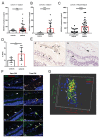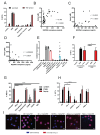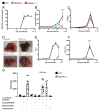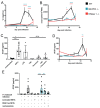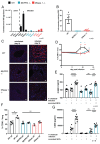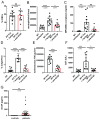
| PMC full text: | Sci Immunol. Author manuscript; available in PMC 2020 Apr 18. Published in final edited form as: Sci Immunol. 2019 Oct 18; 4(40): eaaw0336. doi: 10.1126/sciimmunol.aaw0336 |
Figure 2

(A) In vitro stimulation of neutrophils isolated from healthy individuals (n=3) with malaria associated PAMPs and DAMPs (n = 3). (B - D) Spearman correlation of NETs and heme concentration in malaria patients of all three cohorts presented in Fig. 1. (E) Quantification of NETosis of healthy neutrophils in response to plasma (10% v/v) from malaria patients, PMA (50 nM) or heme (20 μM) in combination with TNF priming. Hx refers to treatment with 70 μM hemopexin for 30 min prior to stimulation. (F) Quantification of NETosis in neutrophils from healthy donors (n=3) and CGD patients (n=3) in response to PMA and heme. (G) Quantification of NETosis in response to PMA and heme in neutrophils from healthy donors (n=3) preincubated with inhibitors at the following concentrations: 1 μM Go6983 (PKCi), 30 uM pyrochatecol, 1 μg/ml cycloheximide, 2.5 μM abemaciclib (CDK6i), 10 μM BB-Cl-amideine (PAD4i) and 20 μM GW311616A (NEi). (H) Quantification of NET formation in mouse peritoneal neutrophils (n = 3) in response to PMA (100 nM) and heme (20 μM) with TNF pretreatment. (F-H): all graphs display mean ± SEM. (I) Representative images used for mouse NET quantifications, showing staining for DNA (blue) and histone H2A/H2B-DNA (red). Scale bars = 20 μm. Asterisks indicate significance: *P<.05, **P<.01, ***P<.001 by Welch’s t-test.
